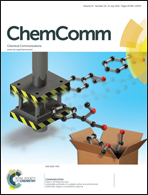Complete reductive cleavage of CO facilitated by highly electrophilic borocations†
Abstract
The addition of CO to [((R3N)BH2)2(μ-H)][B(C6F5)4] leads to formation of trimethylboroxine ((MeBO)3) and [(R3N)2BH2][B(C6F5)4]. When R = Et, [(Et3N)H2B(μ-O)B(CH3)NEt3][B(C6F5)4], is isolated and demonstrated to be an intermediate in the formation of (MeBO)3.


 Please wait while we load your content...
Please wait while we load your content...